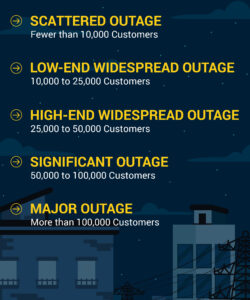When natural disasters strike, like hurricanes, ice storms, or tornadoes, the visible damage, such as downed trees, flooding, and power outages, is only part of the story. Behind the scenes, utility crews, traffic control professionals, and first responders are working around the clock to protect public safety and restore essential services. At Flagger Force, our crews work 24/7/365 to respond to extreme weather events and keep our communities moving. We’re honored to partner with utility clients who share our commitment to ensuring roads are cleared, power is restored, and communities can begin the path to recovery.
In 2024, Flagger Force was called into action in the aftermath of Hurricane Helene, sending over 100 team members to support Duke Energy and their key contractor partners in emergency power restoration in the storm ravaged areas of Western North Carolina. Our organization saw firsthand the level of detail and coordination that the Duke Energy team put into their storm response efforts, which inspired us to connect with them to learn more about their strategy.
We recently sat down with Jason Hollifield, Vice President of Upstate Zone Operations for Duke Energy Carolinas, for an in-depth conversation about the company’s storm response strategies and its commitment to protecting electric and natural gas customers through every phase of a severe weather event. In his role, Jason is responsible for emergency preparedness in North and South Carolina, ensuring the company is ready for any type of emergency that might interrupt customers across those states. When emergencies strike, he steps into the role of regional commander, leading coordinated response efforts on the ground.
Explore our conversation with Jason to learn more about Duke Energy’s vital work during extreme weather events, the innovative response strategies they use, and their ongoing commitment to keeping communities safe.
What is Duke Energy’s geographic footprint, and how many customers does the company serve?
Jason: The company’s electric utilities serve 8.6 million customers across Florida, Indiana, Kentucky, Ohio, North Carolina, and South Carolina. Its natural gas utilities serve 1.7 million customers across Ohio, Kentucky, Tennessee, North Carolina, and South Carolina.
How does Duke Energy identify the need to go into storm response?
Jason: We have a team of five meteorologists who continuously monitor weather conditions and track potential storms. They typically begin analyzing forecasts at least seven days in advance and alert us to any weather threats that could impact our customers. Our meteorologists inform us if an impending storm is likely to fall into one of these categories:

If a storm poses a major threat and could potentially affect more than 100,000 customers, we begin initial discussions as soon as it forms and a projected path is identified. In the early stages, conversations are primarily between me and the meteorologists. However, once the storm is about four to five days out, I begin assembling a broader response team to prepare for potential impacts.
Once Duke Energy identifies the need to go into storm response, how does the team proactively prepare?
Jason: Once we’re aware of an approaching storm, it’s essential we notify and prepare our field teams and make sure our contractors are informed and ready to respond. We also begin assessing the anticipated resource needs and comparing them to the availability and position of our internal teams and materials. For significant weather events, we have a tool that allows us to input the weather assumptions, like precipitation, wind speeds, the duration of wind speeds, etc. It will calculate the number of anticipated outages and impacted customers, as well as the total resource requirement for vegetation, line, and leadership for each of our 71 operations centers in the Carolinas. Using these calculations, we can evaluate whether our native resources will be adequate or not.
If we identify a deficit of resources, we have a few options. One option is to bring in support from other regions that are not expected to be affected by the storm. For example, if a storm is projected to hit North and South Carolina, we can pull in field employees and materials from our operations centers in the Midwest and Florida. Another path is to request mutual assistance from other investor-owned utilities. Duke Energy is a member of four mutual assistance groups across the United States, including the Southeastern Electric Exchange, as well as groups covering the Midwest and Great Lakes regions, allowing us to quickly seek support when needed. Another factor that sets Duke Energy apart is our proactive approach to storm preparedness through our corporate sourcing group. We have pre-established contracts with approximately 200 companies that provide support resources in the Carolinas. Together, these companies represent a workforce totaling tens of thousands of people. When needed, we can directly leverage these companies for assistance. If conditions become severe, we have the ability to enter short-term, single-source contracts with companies we don’t already have agreements with.
What type of training is required to prepare for storm response efforts?
Jason: During a storm, we rely on several critical applications, such as our crew tracking tool, outage management system, and damage assessment application, to coordinate and monitor response efforts. Because these tools are essential, it’s important that team members are well-trained in how to use them. We identify individuals who are likely to be involved during storm events and provide in-person, hands-on training sessions. These sessions include demonstrations and step-by-step instructions on how to use each system. The training sessions are recorded and shared as refreshers, and we also offer computer-based options as an additional learning resource.
In addition to training, we coordinate monthly meetings with key internal teams to ensure everyone understands their roles, is familiar with our processes, and is prepared to quickly activate and carry out storm response efforts.
Tell us about the people who support Duke Energy’s storm response efforts and their responsibilities.
Jason: We have several groups in our command centers, such as the planning, liaison/public information, and logistics teams, who proactively prepare and refine our response strategies. Our core teams and their responsibilities include:
- Planning Team – Strategizes base camps, determines estimated times of restoration (ETRs), identifies the number of resources needed, develops customer communication plans, and leads assessment efforts. The planning team receives a lot of information from individuals upstream and must pass details downstream to other groups to be effective.
- Logistics Team – Oversees the setup of all our base camps and manages vendor relationships to ensure the individuals who are working for us have access to alternative housing, restrooms, showers, food, and laundry services during storm response. Duke Energy brings in a lot of external resources to ensure needs are met during these events, and the logistics group plays a critical role in coordinating all the details.
- Liaison Team & Public Information Team – Handles communication with Duke Energy’s key leaders and community partners. These teams include professionals from account management, community and government relations, and corporate communications. They coordinate with county emergency management teams, issue press releases, and deliver timely updates to customers and stakeholders.
- Operations Team – Leads on-the-ground restoration efforts, oversees field organization, ensures the safety of frontline workers, and provides direction to crews.

What is Duke Energy’s differentiator in providing storm response services?
Jason: North and South Carolina experience storms year-round, with all four seasons bringing different types of severe weather—from ice storms and high winds to hurricanes and tornadoes. Due to this constant threat, our teams remain active and well-practiced, providing storm response services throughout the entire year.
Duke Energy has adopted an organizational structure that prioritizes storm response. Our President and CEO, Harry Sideris, wanted a dedicated position that prioritized emergency response and readiness—someone who would go to bed thinking about storm preparation and wake up verifying all the right plans, practices, and procedures were in place. Unlike organizations that shift from their “blue-sky role” to their “storm role,” Duke Energy has built storm preparedness into its daily operations.
Having the right plans on paper means little if they are not executed effectively in the field. At Duke Energy, our ability to carry out storm response strategies on the ground and ensure priorities are met is a key differentiator. I think back to Hurricane Helene as a clear example. In the Carolinas, the storm caused massive damage, including 14,000 broken poles, 11,000 transformers, 30,000 crossarms, 9 million feet of overhead conductor, 403 retail/industrial substation outages, 127 wholesale points of delivery out, 187 damaged transmission structures, and the complete loss of four substations. Our experience and strong coordination between transmission and distribution enabled us to quickly get more than 23,000 people on the ground in upstate South Carolina and western North Carolina to support response efforts, including traffic control professionals from Flagger Force. These crews came from 32 states and four Canadian provinces. Every individual had a bed, hot meals, and a purpose each day. They knew what to do, and we had the systems in place to manage, monitor, and observe their progress. That’s not going to happen if you start planning once the storm hits; you must be prepared every single day.

Are there any emerging technologies or processes that help support storm response efforts?
Jason: Drone technology has proven especially valuable in mountainous terrain and coastal areas, where access can be challenging and off-road equipment is often required. The ability to deploy drones for aerial assessments speeds up our damage evaluation process.
From a process standpoint, we spent over a year gathering data and training teams to perform statistical damage assessments. In the Carolinas, we have 71 operations centers grouped into eight zones. For each operations center, we identified seven to 11 smaller pods in the geographic area. Within each pod, we documented the exact number of poles, transformers, and spans of conductor. After severe storms, we dispatch crews to the pods to quickly assess the number of downed trees on conductors, broken poles, and damaged transformers. The data they collect is then used to extrapolate the overall impact across the entire zone, giving us a clear understanding of the storm’s magnitude.
For example, in upstate South Carolina following Hurricane Helene, within four to six hours after the storm had cleared, we estimated we had 6,100 broken poles in just one of our eight zones. That’s more broken poles than we’ve ever had from any storm affecting the entirety of North and South Carolina. It was a shock. However, because the statistical damage assessment was performed quickly and we understood the magnitude of the damage, it allowed us to go further for additional resources on day one. We were much more aggressive in our acquisition of materials for restoration, including poles, transformers, splices, and more. Based on the severity of the storm, we should have run out of resources, but because of the assessment, we always had enough crews and inventory on the ground. Our stores personnel were responsible for traveling between our supply centers, operations centers, and 34 base camps to replenish materials, and they logged over 600,000 miles in just 10 days. The statistical damage assessment provided us with timely information, which allowed us to act aggressively and made a huge difference in our response efforts.
What is Duke Energy’s approach to communicating with customers when a storm strikes?
Jason: Before a major storm, we begin communicating through mass media, social media, and direct email. Our outage management system also plays a key role in customer communication. For example, if a storm affects a specific area, once a crew assesses the damage and identifies what needs to be repaired, we can enter an estimated time of restoration into the system, which triggers a notification to the customers served by that upstream device. We strive to maintain a consistent pace of communication with customers to ensure they receive timely and accurate information throughout the restoration effort.

When I’ve been out in the field following storms, I’ve had customers come by to talk to me and personally thank our crews for their efforts. I know customers appreciate our presence when major storms disrupt service and their normal way of life, and it makes them feel better about the utility serving their community.
Flagger Force is proud to have provided storm response services alongside Duke Energy following Hurricane Helene and appreciates their ongoing dedication to keeping people safe and restoring communities during severe storms. From strategic response plans and innovative processes to cutting-edge technology, Duke Energy is leading the way in storm preparedness. We extend our sincere thanks to Jason Hollifield for sharing his time, leadership, and storm response expertise with us.

